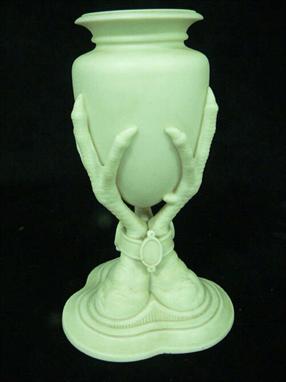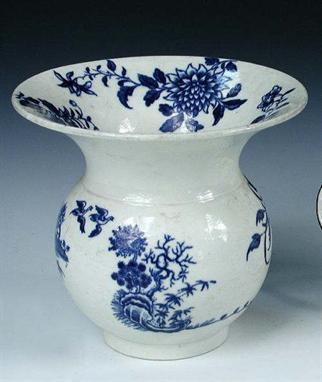We found 182975 price guide item(s) matching your search
There are 182975 lots that match your search criteria. Subscribe now to get instant access to the full price guide service.
Click here to subscribe- List
- Grid
-
182975 item(s)/page
First Period Worcester part Tea and Coffee Service, comprising eight tea bowls, two tea cups, eight saucers, four saucer dishes, milk jug, sugar bowl, cover and stand, teapot, each piece decorated in cobalt blue and gilt with floral sprigs, some marked, blue crescent mark and a similar teapot and cover, (31).
A garniture of three 1760s Chelsea vases and covers, the figure painting on one side attributed to John Donaldson, the reverses of the two handled bodies painted with birds in the manner of James Giles, all within gilt foliate frames on a watery deep blue ground, the pair 25cm high and the single 28cm (R) (6) John Donaldson was at Chelsea from 1761 to 1765 when he went to Worcester where he was to collaborate with J H O'Neale on the famous garniture in the Dyson Perrins Museum
A LARGE TURKISH RED GROUND CARPET with all over continuing geometric decoration in blue, green and orange within a multiple border, approximately 11.4 m x 7.6m or 37'4" x 24' 9". The overall condition is poor, there are numerous splits and holes and the carpet has been cut and re-joined in several places. This lot is sold Ôas found' and the buyer is responsible for removal within five working days of the sale date The carpet is being sold by order of Worcester College, Oxford and is to be viewed in the College Dining Room only within specific hours. It can be viewed at the College on the Saturday prior to the sale between 10am and 12md; Monday and Tuesday between 9am and 12md and 2.30pm and 5pm. Enquire at the Lodge.
Good quality Edwardian Asprey's two person picnic set comprising Britannia metal kettle and teapot with carved mounts, milk jug, sugar bowl, canisters, burner and stand and pair of Royal Worcester white and gilt teacups and saucers with spoons, all contained in fitted leather case with purple velvet lining and fall front
Royal Worcester Bottle Neck Vase with applied grotesque horned masks, Peach Ivory Ware approx. 12'h with puce back stamp Reg. No. 141377 & 1408 patent to base. Royal Worcester 2 Handled Vase & Cover approx. 8'h with hand painted cartouche to front monogrammed SW, rear cartouche gold depicting goats/sheep, gold back stamp with '89 Celebrating 200 Years (2)
Scottie Wilson-Royal Worcester-A circular box and cover with conforming stand decorated with black transfer fish and swans within repeat pattern borders over a terracotta ground, printed marks, width 16.5 cms, together with two sets of six rectangular hors d'oeuvre's trays with a Greek key pattern.
A mounted group of eight miniature dress medals representative of the medals awarded to Major C. Probert, Royal Electrical and Mechanical Engineers, late Royal Tank Corps, British War and Victory Medals; 1939-45 Star; Defence and War Medals; Army Meritorious Service Medal, E.II.R., 1st issue; Army L.S. & G.C., G.V.R., 3rd issue, Regular Army; Efficiency Decoration, G.VI.R., 1st issue, Territorial, mounted for display, very fine and better (8) £30-50 Cecil Probert was born in Worcester on 22 April 1894. During the Great War he served in the ranks of the Tank Corps, and re-enlisting in 1919 he attained the rank of R.S.M. in the Corps before being commission in July 1939. With the Royal Tank Corps he served in France and was evacuated from Dunkirk. He was promoted to Captain in the R.A.O.C. in 1941 and Acting Major in the R.E.M.E. in 1943. He was mentioned in despatches (London Gazette 20 December 1940), granted the Efficiency Decoration (London Gazette April 1950) and was awarded the M.S.M. in 1963. Major Probert died in Worcester in December 1976. Sold with a quantity of copied research. These medals are representative of the awards to the above and have been assembled in recent years for display purposes.
Seven: Warrant Officer 1st Class F. G. Perkes, Royal Army Service Corps Queens South Africa 1899-1902, 3 clasps, Cape Colony, South Africa 1901, South Africa 1902 (17753 Pte. F. Perkes, A.S.C.); 1914 Star (S-17753 S.Q.M. Sjt. F. G. Perkes, A.S.C.); British War and Victory Medals, M.I.D. oak leaf (S-17753 W.O. Cl. 1 F. G. Perkes, A.S.C.); Army L.S. & G.C., G.V.R., 1st issue (S/17753 S.S. Mjr. F. G. Perkes, R.A.S.C.); Army Meritorious Service Medal, G.V.R., 1st issue (OAS-17753 S.S. Mjr. F. G. Perkes, A.S.C.); French Medal of Honour, with swords, bronze, initials officially corrected on the fifth, generally very fine or better (7) £300-350 Frederick George Perkes was born in Worcester in 1879, where he enlisted in the Army Service Corps in January 1901, direct from the 2nd (Volunteer) Battalion, Worcestershire Regiment. Embarked for South Africa that May, he remained stationed there until returning home in May 1906, which period witnessed his participation in the Boer War and advancement to Lance-Corporal in October 1902 and to Corporal in November 1903. Service in Crete and Malta followed in 1908-13 and, having been promoted to Sergeant in June 1906 and to Staff Sergeant in October 1910, he was advanced to Warrant Officer 2nd Class on the outbreak of hostilities. Thereafter, with the exception of a fortnights home leave, he served continuously in France and Belgium from August 1914 until October 1920, was advanced to Warrant Officer 1st Class in March 1915 and was mentioned in despatches (London Gazette 24 December 1917 refers). In addition, he was awarded the M.S.M. In recognition of valuable services rendered with the forces in France during the present war (London Gazette 17 June 1918 refers), and the French Medal of Honour (London Gazette 8 March 1920 refers); although the latter was gazetted as a silver issue, his Regular Army Certificate of Discharge states that he was in possession of a bronze issue - in addition to confirming all of his other Honours & Awards. Discharged in January 1926, Perkes joined the R.A.S.C. (Territorials) as a Company Quarter-Master Sergeant, but was again discharged, at his own request, a few months later; sold with his original Soldiers Service and Pay Book, and his Regular Army Certificate of Discharge.
A Great War Western Front M.M. pair awarded to Serjeant J. Nicholls, Worcestershire Regiment Military Medal, G.V.R. (5157 Sjt., 4/Worc. R.); Queens South Africa 1899-1902, 2 clasps, Cape Colony, Orange Free State (5157 Corpl., Worcester. Regt.) second with edge bruising and contact marks, good fine; first good very fine (2) £300-350 M.M. London Gazette 11 November 1916. Joseph Nicholls was born in Dudley, Worcestershire and enlisted into the Worcestershire Regiment in March 1893 and was to remain with them for the rest of his life. He served in South Africa where he gained the QSA and two clasps. In 1903 the Battalion went to Malta, in 1905 to India and in 1909 to Burma. Nicholls was present when the 4th Battalion was stationed at Bareilly, and took part in the Grand Parade in Delhi to mark the visit of King George V. For this participation he was awarded the Delhi Durbar Medal. After the tour in Burma the Battalion returned to England on 1 February 1915 ready for action in the First World War. The 4th Battalion left Avonmouth on 21 March 1915 as part of 88th Brigade, 29th Division. After passing through Egypt the Battalion, including Nicholls, arrived at Gallipoli on 24 April 1915 and went ashore under heavy fire. The battalion at that time consisted of 29 officers and 931 other ranks. Part of X Company reached the River Clyde and attempted to land at V Beach, but most were killed or wounded. The remainder of the Battalion landed on W Beach and formed up with Z and Y Companies in front, and X and Y Companies in support. They then moved forward using the bayonet to clear the enemy from Hill 138. In the advance towards Krithia, the Battalion again launched a bayonet charge and by the end of April had suffered 35 killed, 199 wounded and 74 missing. During May the Battalion continuously fought along the firing line between the Krithia Nullah and Gully Ravine and by the end of the month their strength was reduced to 11 officers and 483 other ranks. In June and July the Battalion took part in the Third Battle of Krithia and during this time Lieutenant H. James earned his VC for outstanding courage in defence and leading attacks. From July to December the Battalion was rarely out of action. In September they suffered heavily at Sulva Bay and amongst those killed was Lieutenant James shot by a sniper. In October all 20 officers in the Battalion were Second Lieutenants and it was not till the 26th that Captain Kerans took command of the Battalion. On the night of 7/8 January 1916 the Battalion embarked from W Beach and sailed back to Egypt. They had been in action from the beginning of the campaign to the very end and had lost 64 officers and 1550 other ranks killed, wounded or died from other causes. A total of 1614 dead. From Egypt the Battalion was posted to France, arriving at Marseilles on 20 March 1916, still part of 88 Brigade, 29th Division. In France/Flanders they fought in every major battle until the 11th November 1918, including the Somme from 1 July to the 18 November 1916, then at Albert, Le Transloy, Arras, Scarpe, Ypres 1917, Langemarck, Polcappelle, Cambrai, Estaires, Lys, Bailleul, Kemmel, Ypres 1918 and finally at Courtrai in October 1918. For his services in France, Nicholls was awarded the Military Medal. Company Sergeant-Major Joseph Nicholls died on 30 January 1919, aged 38 years, and was buried at the Holy Trinity Church, Amblecote. He was the son of Mrs May Nicolls who lived at 36 High Street, Amblecote. Sold with copied research.
A mahogany crossbanded and inlaid oak eight-day longcase clock, J. Jeffris, Worcester, circa 1770, the four-pillar rack and bell striking movement with 12 inch square brass dial with subsidiary seconds dial and calendar aperture to the matted centre within an applied silvered Roman numeral chapter ring with Arabic five minutes signed J. Jeffris, Worcester to lower edge, with foliate scroll cast spandrels to angles, the case with broken pediment and turned pilasters to hood above oval fan cartouche centred rectangular trunk door and plinth base with moulded skirt, 226cm high. John Jeffris is recorded in Baillie, G.H. Watchmakers & Clockmakers of the World as working in Worcester from 1758.
John Speed. Hand coloured engraved map of Worcestershire . With a panel of five Coats of Arms and an inset town plan of Worcester. A battle scene at the base Evesham. Dated 1610 To be sold by Thomas Bassett in Fleet Street and Richard Chiswell in St. Paul's Churchyard. Described verso in English. Framed and double glazed. h: 15 x w: 20 in.
-
182975 item(s)/page
















































